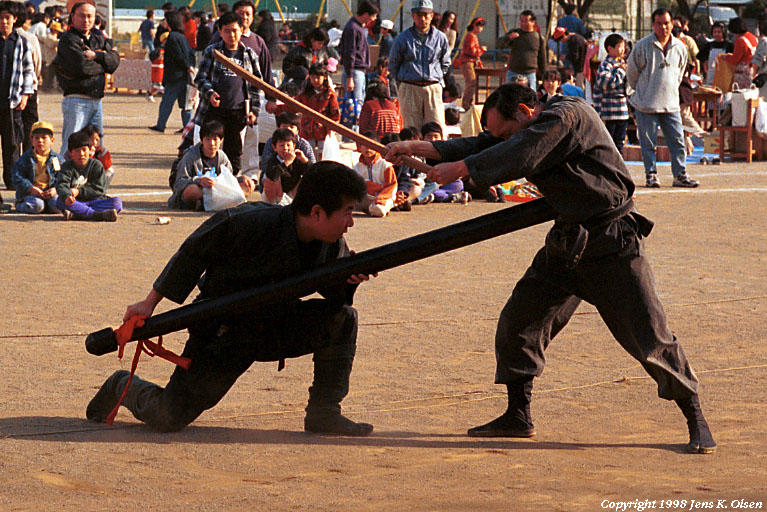 While the samurai swords get most of the attention these days, the truth is that during the Sengoku, or Warring States, Period of Japanese history, the primary battlefield weapon of the samurai was some kind of polearm. Most martial traditions, or Ryu, developed and taught specific tactics and techniques for their use.
While the samurai swords get most of the attention these days, the truth is that during the Sengoku, or Warring States, Period of Japanese history, the primary battlefield weapon of the samurai was some kind of polearm. Most martial traditions, or Ryu, developed and taught specific tactics and techniques for their use.One the left is a miniature figure wielding a naginata. By the late fifteenth century, these had actually fallen out of favor among most warriors. But for centuries priviously, this long shaft topped by a deadly, curved single edged blade was an extremely popular weapon. The Sohei, or warrior monks, were particularly well known for their expertise with this weapon.
 The miniature on the right is armed with an unusual weapon, the O-Tsuchi, or warhammer. This was not a nimble weapon, and required a high degree of skill to use effectively on the battlefield. The advantage was that it crushed through armor easily. This was very useful against other well-armored samurai, but not as effective against the increasing number of arquebus-armed, peasants of the light infantry called Ashigaru.
The miniature on the right is armed with an unusual weapon, the O-Tsuchi, or warhammer. This was not a nimble weapon, and required a high degree of skill to use effectively on the battlefield. The advantage was that it crushed through armor easily. This was very useful against other well-armored samurai, but not as effective against the increasing number of arquebus-armed, peasants of the light infantry called Ashigaru.The strangely shaped tool on the left is a juji-yari, or cross-shaped spear. The normal spear was the most popular primary weapon of the Sengoku samurai. It could be used as a lance in a cavalry role, and as a pike or light halberd in close combat. The Juji yari was popular among advanced practitioners for its hooking and trapping abilities.

On the right, the two gentlemen in white on the basketball court are demonstrating a kata
 from the Hozoin Ryu of sojutsu, or spearmanship. The Hozoin Ryu belonged to a temple of warrior monks and because they were willing to teach outsiders, it was a popular desitination for warriors wishing to test their skills. It was widely regarded as one of the most powerful forms of spear technique, and Miyamoto Musashi was suppossedly defeated by Hozoin monks several times before harnessing the essence of his own technique and defeating their champion. But this is one of many possible apocryphal stories about him.
from the Hozoin Ryu of sojutsu, or spearmanship. The Hozoin Ryu belonged to a temple of warrior monks and because they were willing to teach outsiders, it was a popular desitination for warriors wishing to test their skills. It was widely regarded as one of the most powerful forms of spear technique, and Miyamoto Musashi was suppossedly defeated by Hozoin monks several times before harnessing the essence of his own technique and defeating their champion. But this is one of many possible apocryphal stories about him.On the left is Masaaki Hatsumi, head of the Bujinkan. He is brandishing a dai-katana. These were oversized swords used much the same way their two-handed broadsword counterparts were used in Europe: to smash apart lines of pikemen protecting musketeers. The dai-katana was heavy and slow, but it was devastating in the chaos of clashing battlelines.

 Which brings us back to the Naginata. The two pictures of naginata wielding martial artists give some hint of the fierce motions of their practical use. The nagainata were whirled around the user in a furious tornado of energy. The great sweeping cuts often amputated heads and limbs, especially legs. The blunt end of the shaft battered aside the defender's weapons or stunned them with strikes before the blade end finished the job.
Which brings us back to the Naginata. The two pictures of naginata wielding martial artists give some hint of the fierce motions of their practical use. The nagainata were whirled around the user in a furious tornado of energy. The great sweeping cuts often amputated heads and limbs, especially legs. The blunt end of the shaft battered aside the defender's weapons or stunned them with strikes before the blade end finished the job. This last tool went by many names. One of the most common is Tetsubo. It is a large, heavy battlefield version of the bo staff. Like the O-Tsuchi, the tetsubo required a great deal of agility to use. A good practioner wielded the Tetsubo as both an offensive weapon, and a defensive shield. By dancing around the weapon, the warrior could "hide" himself behind the log-like shaft of the Tetsubo. It is a surprising weapon to see in action, and requires extraordinary skill to use well.
This last tool went by many names. One of the most common is Tetsubo. It is a large, heavy battlefield version of the bo staff. Like the O-Tsuchi, the tetsubo required a great deal of agility to use. A good practioner wielded the Tetsubo as both an offensive weapon, and a defensive shield. By dancing around the weapon, the warrior could "hide" himself behind the log-like shaft of the Tetsubo. It is a surprising weapon to see in action, and requires extraordinary skill to use well.







3 comments:
jrf - Greatly enjoy the history lessons. Keep them coming.
Sure, But I'm trying to figure out how the post ended up all the way down here...
I almost missed this. Great stuff. Love it.
Post a Comment